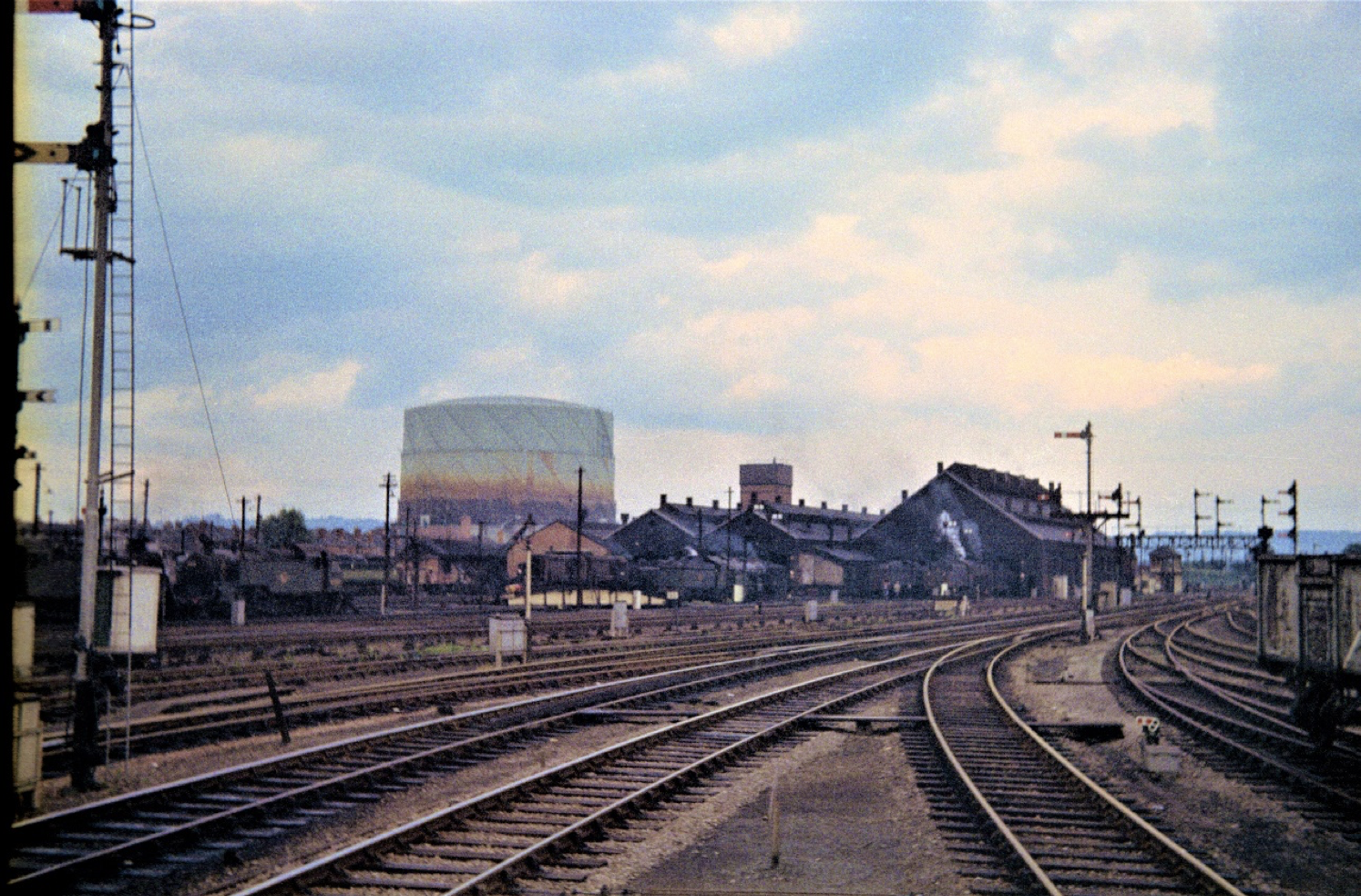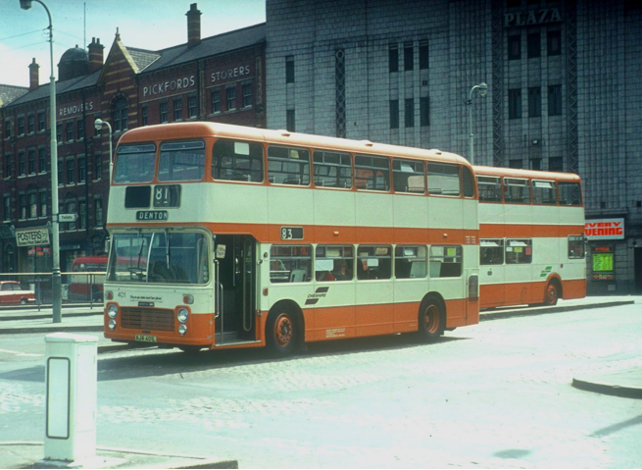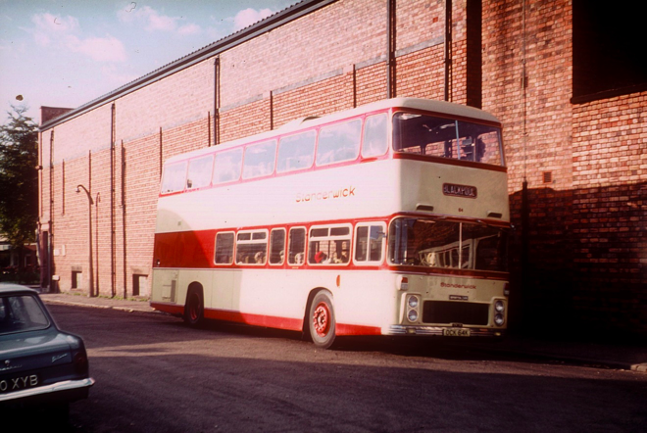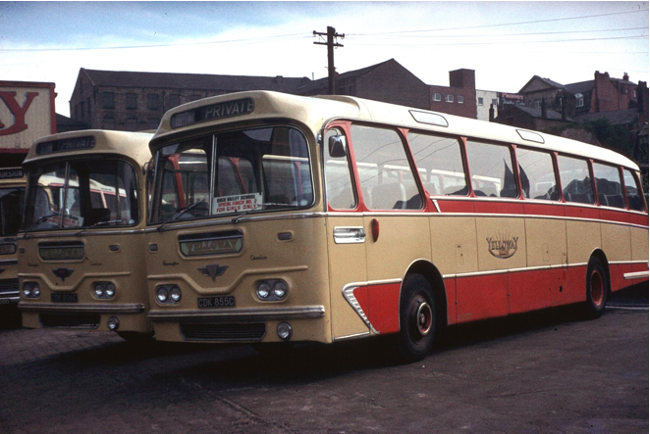Other Operators
West Midlands
Whilst at Keele, I took a passing interest in the bus fleets of the West Midlands as I frequently passed through their territory during my travels by coach to and from University. The setting up of the West Midands PTE resulted in the absorption of the Wolverhampton, Walsall, and West Bromwich fleets into a new West Midlands fleet, based firmly on the ideas of Birmingham Corporation Transport, by far the largest of the constituents. The Walsall fleet was especially interesting containing many non-standard vehicles, some of which were rebuilt by the Corporation. It was also one of the last municipal undertakings to retain trolleybuses, finally being withdrawn in 1970 when the fleet was absorbed into WMPTE.
On 3 December 1973, the fleet was further enlarged when, consequent upon the break-up of Midland Red, BMMO vehicles and garages in the WMPTE area were transferred to the PTE fleet and buses repainted in the blue and cream livery based on that of BCT. The garages concerned were those at Oldbury, Dudley, Sutton Coldfield, Stourbridge and Hartshill. Later, the fleet of Coventry Corporation Transport was absorbed into WMPTE on 1 April 1974.
In September 1978, the rump of Midland Red, based in Redditch, and now confined to areas outside the West Midlands PTE area, was one of the early constituents of the NBC to undertake a Market Analysis Project (MAP). This was the first attempt by bus companies to collect passenger data systematically, with the intention of creating bus routes that better matched passenger demand. Eventually, on 5 September 1981, Midland Red was broken up into six separate area companies which subsequently were taken over by larger private concerns: North (Arriva), South (Stagecoach), East (Midland Fox), West (First), Midland Red Coaches, and Central works. [ref: midlandred.net]
Several independent operators also worked into the West Midland area. Green Bus, of Westbrook, Rugeley had a mixed fleet including second-hand Bristol LDs from Crosville, AEC Reliance coaches with Willowbrook bodies, and Seddon Pennines with Seddon bodies. Midland Red took over the fleet on 5 November 1973. Harper Bros of Heath Hayes, Cannock had a small fleet including double-deckers which worked a trunk route from Hednesford and Cannock to Birmingham. They were also taken over by Midland Red on 7 September 1974.
Another company that worked into Burton-on-Trent was Stephensons (Uttoxeter) Ltd, of the Garage, Spath who used a yellow and black livery. Their fleet consisted of a mixed batch of vehicles, including some ex-LT RTLs, two Leyland coaches with Weymann Fanfare bodies from Sheffield, and various Leyland PD3s.
Another fleet common in the Keele area on private hire duties was that of Salopia Saloon Coaches Ltd., of Green End Whitchurch. They had a large, standardised fleet of modern coaches, usually Bedford / Duple combinations, in a pleasant two-tone green livery, and occasionally supplied coaches for Keele sports visits.
WMPTE continued to provide bus services until 26 October 1986, when deregulation of bus services was introduced. On that day, a totally independent organisation, West Midlands Travel was set up to provide services to the WMPTE.
Manchester buses
Being based at Keele, Manchester was in easy reach by train or express coach. As became more interested in buses, I joined the Omnibus Society and took the regional newsletters of the PSV Circle.
Trips to the Manchester area provided plenty of opportunity to view fleet operations. I had seen many of the Lancashire fleets before, on my wanderings around the area in the days leading up to August 1968, and the end of steam on BR.
In 1968 Manchester had introduced their rear-engined ‘Mancunian’ based on Leyland Atlantean (numbered in the 1000 series) or Daimler Fleetline chasses (2000 series). These vehicles had bodies built to Manchester’s own specification and appeared much larger and box-like compared to other vehicles around at the time. They were produced up to 1970.
On 1 November 1969, following the implementation of the 1968 Transport Act, the SELNEC (South-East Lancashire and North-East Cheshire) Passenger Transport Authority was created, which effectively put all municipal operators in the greater Manchester area under one controlling organisation. Fleets taken over by SELNEC included Ashton-under-Lyne, Bolton, Bury, Leigh, Oldham, Ramsbottom, Rochdale, Salford, SHMD, and Stockport. Some buses ordered by Salford but delivered after the creation of SELNEC were bodied to the ‘Mancunian’ style. From 1972, these were superseded by a new SELNEC ‘standard’ double-deck bus, based on the Leyland Atlantean or Daimler Fleetline chassis, numbered in the 7000 and 8000 series.
In March 1972, SELNEC took over a substantial part of the NBC North Western fleet, along with depots at Altrincham, Glossop, Oldham, Stockport, and Urmston. This led to the break-up of the North Western fleet, most of that area outside the SELNEC area (Macclesfield and Northwich) being transferred to Crosville, who already covered part of the area with depots in Crewe, Warrington, and Liverpool. Trent took over the Derbyshire operations of North Western based on Buxton and Matlock. However, in a reverse move, the former Cheshire operations at Northwich were transferred away from SELNEC to Crosville from 21 May 1973.
SELNEC was replaced by Greater Manchester Transport on 1 April 1974 following local government reorganisation, being managed by the Passenger Transport Executive, which also had powers to manage local railway services. It also additionally incorporated Wigan Corporation Transport from this date. From 1 January 1976, Lancashire United Transport (LUT), based at Atherton became a wholly owned subsidiary of GMT, but was not completely absorbed until April 1981. LUT had other depots were at Hindley and Swinton.
A decade later, political demands meant that the GMPTE fleet was broken up, and in December 1993, was split into GM North and GM South, subsequently being bought respectively by First and Stagecoach.
A Bristol VR 1401 AJA401L with ECW bodywork ordered by North Western but delivered in SELNEC Cheshire livery enters Stockport bus station in summer 1972 on route 81 to Denton
Ribble
My first memories of Ribble, based in Preston, go back to the 1950’s when they used to run a coach service in summer from Liverpool to Bristol (X25) that travelled up the A38 past Crypt School in late morning, and at about 7pm in the evening southbound. In the winter this service never ran beyond Cheltenham. In those days Hebble based in Halifax had identical coaches, Leyland Royal Tigers with Burlingham coach bodies and a similar livery, so I thought they were related. The coincidence is that both were named after rivers that ran through their towns. In about 1957, double-decker ‘Gay Hostess’ coaches were introduced onto the X25, in the NRN600 batch. They were Leyland Atlanteans with Weymann coach bodies. They would be replaced in due course (particularly on the London services) by Bristol VRLs in 1970.
Ribble, previously a BET company, became part of NBC on 1 January 1969. The fleet was almost entirely of Leyland origin, although a quantity of Bristol REs had been introduced prior to the introduction of the National livery to the fleet. The first batch of Bristol VR double-deckers was dispatched to Carlisle to convert the city services to OMO on 3 June 1972. They replaced a fleet of full-fronted Leyland PD3s with Burlingham bodies which were very pleasant vehicles. The advent of the NBC also allowed Ribble to take over United’s Carlisle operations in 1969. By 1987, a day trip to Carlisle via the Settle & Carlisle line showed that city routes were being worked by ECW-bodied Leyland Atlanteans, and Mercedes Benz minibuses.
W. Hunniball was General Manager of Ribble during the nineteen-sixties: I mention this because, whilst working as a temporary clerk at the Gloucester 1 Tax Office, I got into discussion with the Tax Inspector. I discovered that he was acquainted with Mr Hunniball, as they both came from Preston! Mr Hunniball died in 1974.
Standerwick VRL coach 64 OCK64K calls at Newcastle-under-Lyme en route from London to Blackpool in 1972.
Yelloways
When at Keele I often went home by coach, which was always an enjoyable trip as I usually caught the Yelloways of Rochdale service X5 from School Street in Newcastle at 10.55am to Cheltenham via Stafford and Wolverhampton, connecting with the 2.30pm departures to Gloucester. However, in summer extra services were run and extended to Torquay, and sometimes one could catch the X5 direct to Cheltenham or Gloucester via the M6 on an accelerated schedule. The services were operated mainly by powerful 12m AEC Reliances with Plaxton Panorama Elite bodies, in the NDK-G and PDK-H batches. They were always double-manned, and as a result, these services were usually very quick! Unfortunately, Yelloways declined in the 1970s, and by summer 1976 most of its services were worked jointly with National Travel.
Two Yelloways AEC Reliance coaches with Harrington Cavalier bodywork CDK855C and CDK856C at the garage in Weir Street, Rochdale. These vehicles were employed on the Cheltenham and Torquay service in the late 1960s, but by the time this photograph was taken in 1972 they were used mainly on local work.
Scotland by coach
Whilst at Keele I spent some time during vacations in Scotland working on a geological mapping project on the Isle of Skye at Elgol. I usually stopped over in Glasgow, where I became acquainted with the local bus fleets, including Glasgow Corporation Transport, famed for its pale green and yellow ochre livery, and its large fleet of Leyland Atlanteans with Alexander bodywork.
One of the more interesting fleets was that of Western SMT, operating on south-west Scotland as far as Carlisle, and using an attractive maroon livery. The fleet had an interesting fleet numbering system which it took me some time to decipher, but it used a fleet number ranging from 1 to around 2400 with a two-letter prefix, the first letter of which was a garage code, and the second a vehicle type. Garages included J (Johnstone) and M (Thornliebank), and vehicle types L for Leyland (D for double-deckers), R for Daimler double-decks, and B and T respectively for Bristol double-decks and saloons.
In Summer 1971 I started fieldwork on Skye. One Saturday morning I caught a Wallace Arnold coach which ran a timetabled service from Glasgow to Portree on the Isle of Skye, leaving at 8.05am from Glasgow (354 Sauchiehall St) to Fort William, before going onward to Broadford. I particularly remember riding on a Leyland Leopard with Plaxton Elite bodywork north along the shores of Loch Lomond and the frustration of the driver as he was checked by slow-moving holiday traffic, including caravans, on the A82 winding alongside Loch Lomond.
I also once went up by Ribble overnight from Liverpool at 10.40pm to Glasgow (Port Dundas Rd). The coach was an old Leyland Leopard / Plaxton Panorama I model whose windows steamed up as we progressed northwards. We stopped at that well-known watering-hole, the Rex Café in Station Square, Lockerbie, for a tea break at two in the morning!
Whilst MacBraynes ran services from Kyleakin and Armadale to Portree on the Isle of Skye, they didn’t run to Elgol. On my 1971 visit the local carrier from Elgol had resorted to using his Renault estate car rather than his minibus to carry passengers from Broadford, and beside myself had to cater for various parcels and a couple of schoolchildren. In 1972, immediately after a Geography field trip to Scotland, I went up to Skye again on 10 April for another 10 days, getting back to Keele for 22nd. On 21 April I caught the new Royal Mail post-bus (only the second in the country) running from Broadford to Elgol and have the first ticket issued [ref: www.countrybus.com/other].



